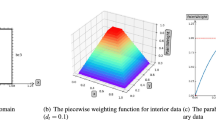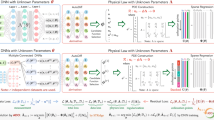Abstract
Many physics and engineering applications demand partial differential equations (PDE) property evaluations that are traditionally computed with resource-intensive high-fidelity numerical solvers. Data-driven surrogate models provide an efficient alternative but come with a substantial cost of training. Emerging applications would benefit from surrogates with an improved accuracy–cost tradeoff when studied at scale. Here we present a ‘physics-enhanced deep-surrogate’ (PEDS) approach towards developing fast surrogate models for complex physical systems, which is described by PDEs. Specifically, a combination of a low-fidelity, explainable physics simulator and a neural network generator is proposed, which is trained end-to-end to globally match the output of an expensive high-fidelity numerical solver. Experiments on three exemplar test cases, diffusion, reaction–diffusion and electromagnetic scattering models, show that a PEDS surrogate can be up to three times more accurate than an ensemble of feedforward neural networks with limited data (approximately 103 training points), and reduces the training data need by at least a factor of 100 to achieve a target error of 5%. Experiments reveal that PEDS provides a general, data-driven strategy to bridge the gap between a vast array of simplified physical models with corresponding brute-force numerical solvers modelling complex systems, offering accuracy, speed and data efficiency, as well as physical insights into the process.
This is a preview of subscription content, access via your institution
Access options
Access Nature and 54 other Nature Portfolio journals
Get Nature+, our best-value online-access subscription
$29.99 / 30 days
cancel any time
Subscribe to this journal
Receive 12 digital issues and online access to articles
$119.00 per year
only $9.92 per issue
Buy this article
- Purchase on Springer Link
- Instant access to full article PDF
Prices may be subject to local taxes which are calculated during checkout



Similar content being viewed by others
Data availability
Datasets to reproduce the findings for the five surrogate models with about 1,000 data points are available on GitHub52. The full dataset and the raw data to create the figure plots in the main text and Supplementary Information can be found on Zenodo53.
Code availability
The code used for these findings can be found on GitHub52.
References
Baker, N. et al. Workshop Report on Basic Research Needs for Scientific Machine Learning: Core Technologies for Artificial Intelligence. Technical Report (USDOE Office of Science, 2019).
Benner, P., Gugercin, S. & Willcox, K. A survey of projection-based model reduction methods for parametric dynamical systems. SIAM Rev. 57, 483–531 (2015).
Willard, J., Jia, X., Xu, S., Steinbach, M. & Kumar, V. Integrating scientific knowledge with machine learning for engineering and environmental systems. ACM Comput. Surv. 55, 1–37 (2022).
Hoffmann, J. et al. Machine learning in a data-limited regime: augmenting experiments with synthetic data uncovers order in crumpled sheets. Sci. Adv. 5, eaau6792 (2019).
Pant, P., Doshi, R., Bahl, P. & Barati Farimani, A. Deep learning for reduced order modelling and efficient temporal evolution of fluid simulations. Phys. Fluids 33, 107101 (2021).
Pestourie, R. et al. Inverse design of large-area metasurfaces. Opt. Expr. 26, 33732–33747 (2018).
Boyd, J. P. Chebyshev and Fourier Spectral Methods 2nd edn (Dover Publications, Inc., 2001).
Pestourie, R., Mroueh, Y., Nguyen, T. V., Das, P. & Johnson, S. G. Active learning of deep surrogates for PDEs: application to metasurface design. npj Comput. Mat. 6, 164 (2020).
Lu, L., Pestourie, R., Johnson, S. G. & Romano, G. Multifidelity deep neural operators for efficient learning of partial differential equations with application to fast inverse design of nanoscale heat transport. Phys. Rev. Research 4, 023210 (2022).
Pestourie, R. Assume Your Neighbor Is Your Equal: Inverse Design in Nanophotonics. PhD thesis, Harvard Univ. (2020).
Bayati, E. et al. Inverse designed extended depth of focus meta-optics for broadband imaging in the visible. Nanophotonics 11, 2531–2540 (2021).
Li, Z. et al. Inverse design enables large-scale high-performance meta-optics reshaping virtual reality. Nat. Commun. 13, 2409 (2022).
Potton, R. J. Reciprocity in optics. Rep. Progr. Phys. 67, 717 (2004).
Li, B. et al. Trustworthy AI: from principles to practices. ACM Comput. Surv. 55, 1–46 (2023).
Oskooi, A. F., Kottke, C. & Johnson, S. G. Accurate finite-difference time-domain simulation of anisotropic media by subpixel smoothing. Optics Lett. 34, 2778–2780 (2009).
Ferziger, J. H., Perić, M. & Street, R. L. Computational Methods for Fluid Dynamics Vol. 3 (Springer, 2002).
Romano, G. OpenBTE: a solver for ab-initio phonon transport in multidimensional structures. Preprint at https://arxiv.org/abs/2106.02764 (2021).
Cranmer, M. et al. Discovering symbolic models from deep learning with inductive biases. Adv. Neural Info. Proc. Syst. 33, 17429–17442 (2020).
Rackauckas, C. et al. Universal differential equations for scientific machine learning. Preprint at https://arxiv.org/abs/2001.04385 (2020).
Hoerl, A. E. & Kennard, R. W. Ridge regression: biased estimation for nonorthogonal problems. Technometrics 12, 55–67 (1970).
Karniadakis, G. E. et al. Physics-informed machine learning. Nat. Rev. Phys. 3, 422–440 (2021).
Lu, L. et al. Physics-informed neural networks with hard constraints for inverse design. SIAM J. Sci. Comput. 43, B1105–B1132 (2021).
Shin, Y., Darbon, J. & Karniadakis, G. E. On the convergence of physics informed neural networks for linear second-order elliptic and parabolic type PDEs. Commun. Comput. Phys. 28, 2042–2074 (2020).
Kochkov, D. et al. Machine learning–accelerated computational fluid dynamics. Proc. Natl Acad. Sci. USA 118, e2101784118 (2021).
Lu, L., Jin, P., Pang, G., Zhang, Z. & Karniadakis, G. E. Learning nonlinear operators via deeponet based on the universal approximation theorem of operators. Nat. Mach. Intell. 3, 218–229 (2021).
Li, Z. et al. Fourier neural operator for parametric partial differential equations. Preprint at https://arxiv.org/abs/2010.08895 (2020).
Koziel, S., Cheng, Q. S. & Bandler, J. W. Space mapping. IEEE Microw. Mag. 9, 105–122 (2008).
Bakr, M. H., Bandler, J. W., Ismail, M. A., Rayas-Sánchez, J. E. & Zhang, Q.-J. Neural space-mapping optimization for em-based design. IEEE Trans. Microw. Theory Tech. 48, 2307–2315 (2000).
Feng, F. et al. Coarse-and fine-mesh space mapping for em optimization incorporating mesh deformation. IEEE Microw. Wirel. Compon. Lett. 29, 510–512 (2019).
Lu, L. et al. Extraction of mechanical properties of materials through deep learning from instrumented indentation. Proc. Natl Acad. Sci. USA 117, 7052–7062 (2020).
Koziel, S., Bandler, J. W. & Madsen, K. A space-mapping framework for engineering optimization-theory and implementation. IEEE Trans. Microw. Theory Tech. 54, 3721–3730 (2006).
Levine, M. & Stuart, A. A framework for machine learning of model error in dynamical systems. Commun. Am. Math. Soc. 2, 283–344 (2022).
Ren, P. et al. Physics-informed deep super-resolution for spatiotemporal data. Preprint at https://arxiv.org/abs/2208.01462 (2022).
Drygala, C., Winhart, B., di Mare, F. & Gottschalk, H. Generative modeling of turbulence. Phys. Fluids 34, 035114 (2022).
Geneva, N. & Zabaras, N. Multi-fidelity generative deep learning turbulent flows. Found. Data Sci. 2, 391–428 (2020).
Hesthaven, J. S., Pagliantini, C. & Rozza, G. Reduced basis methods for time-dependent problems. Acta Numerica 31, 265–345 (2022).
Weinberg, S. The Quantum Theory of Fields Vol. 2 (Cambridge Univ. Press, 1995).
Hou, T. Y., Hwang, F.-N., Liu, P. & Yao, C.-C. An iteratively adaptive multi-scale finite element method for elliptic PDEs with rough coefficients. J. Comput. Phys. 336, 375–400 (2017).
Molesky, S. et al. Inverse design in nanophotonics. Nat. Photon. 12, 659–670 (2018).
Pérez-Arancibia, C., Pestourie, R. & Johnson, S. G. Sideways adiabaticity: beyond ray optics for slowly varying metasurfaces. Optics Expr. 26, 30202–30230 (2018).
Jin, J.-M. The Finite Element Method in Electromagnetics (John Wiley & Sons, 2015).
Svanberg, K. A class of globally convergent optimization methods based on conservative convex separable approximations. SIAM J. Optim.12, 555–573 (2002).
Liu, D. C. & Nocedal, J. On the limited memory BFGS method for large scale optimization. Math. Program. 45, 503–528 (1989).
Huber, P. J. in Breakthroughs in Statistics: Methodology and Distribution (eds Kotz, S. & Johnson, N. L.) 492–518 (Springer, 1992).
Lakshminarayanan, B., Pritzel, A. & Blundell, C. Simple and scalable predictive uncertainty estimation using deep ensembles. In Proc. 31st International Conference on Neural Information Processing Systems (eds von Luxburg, U. et al.) 6405–6416 (Curran Associates Inc., 2017).
Goodfellow, I., Bengio, Y. & Courville, A. Deep Learning (MIT Press, 2016).
Kingma, D. P. & Ba, J. Adam: a method for stochastic optimization. Preprint at https://arxiv.org/abs/1412.6980 (2014).
Innes, M. Flux: elegant machine learning with Julia. J. Open Source Softw. 3, 602 (2018).
Innes, M. Don’t unroll adjoint: differentiating SSA-form programs. Preprint at https://arxiv.org/abs/1810.07951 (2018).
Champagne II, N. J., Berryman, J. G. & Buettner, H. M. FDFD: a 3D finite-difference frequency-domain code for electromagnetic induction tomography. J. Comput. Phys. 170, 830–848 (2001).
Sacks, Z. S., Kingsland, D. M., Lee, R. & Lee, J.-F. A perfectly matched anisotropic absorber for use as an absorbing boundary condition. IEEE Trans. Antennas Propag. 43, 1460–1463 (1995).
Pestourie, R. & Das, P. payel79/peds: publish. Zenodo https://doi.org/10.5281/zenodo.8342595 (2023).
Pestourie, R. & Das, P. PEDS datasets and figure data. Zenodo https://doi.org/10.5281/zenodo.10011958 (2023).
Acknowledgements
R.P. was supported by the US Army Research Office through the Institute for Soldier Nanotechnologies (grant award no. W911NF-18-2-0048) and the MIT-IBM Watson AI Laboratory. We thank M. Dost for her suggestions in proof reading.
Author information
Authors and Affiliations
Contributions
R.P., Y.M., C.R., P.D. and S.G.J. designed the study, contributed to the machine-learning approach and analysed results. R.P. led the code development, software implementation and numerical experiments. R.P. and S.G.J. were responsible for the physical ideas and interpretation. All authors contributed to the algorithmic ideas and writing.
Corresponding authors
Ethics declarations
Competing interests
The authors declare no competing interests.
Peer review
Peer review information
Nature Machine Intelligence thanks Bamdad Hosseini and the other, anonymous, reviewer(s) for their contribution to the peer review of this work.
Additional information
Publisher’s note Springer Nature remains neutral with regard to jurisdictional claims in published maps and institutional affiliations.
Supplementary information
Supplementary Information
Eighteen sections of Supplementary Discussion, Figs. 1–4 and Tables 1–4.
Rights and permissions
Springer Nature or its licensor (e.g. a society or other partner) holds exclusive rights to this article under a publishing agreement with the author(s) or other rightsholder(s); author self-archiving of the accepted manuscript version of this article is solely governed by the terms of such publishing agreement and applicable law.
About this article
Cite this article
Pestourie, R., Mroueh, Y., Rackauckas, C. et al. Physics-enhanced deep surrogates for partial differential equations. Nat Mach Intell 5, 1458–1465 (2023). https://doi.org/10.1038/s42256-023-00761-y
Received:
Accepted:
Published:
Issue Date:
DOI: https://doi.org/10.1038/s42256-023-00761-y



